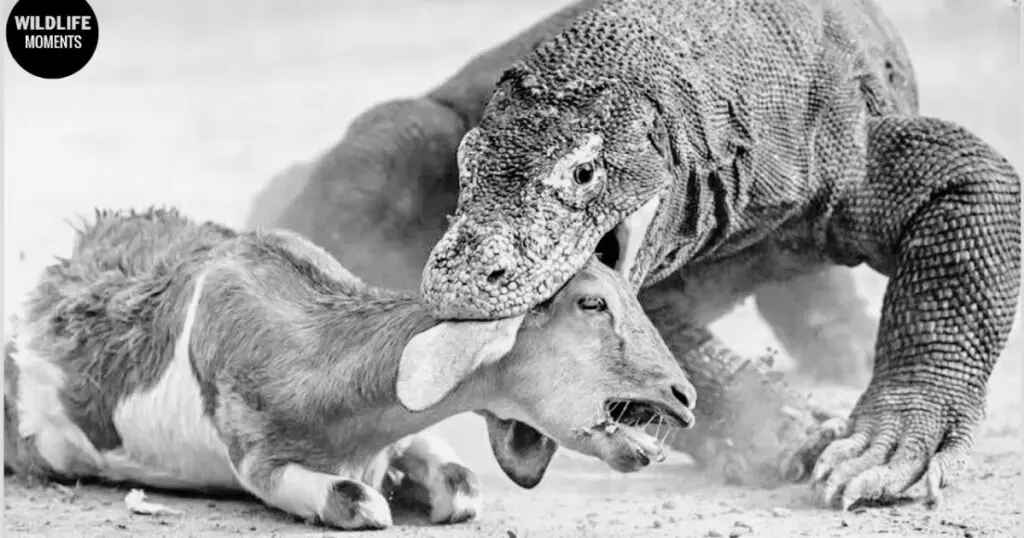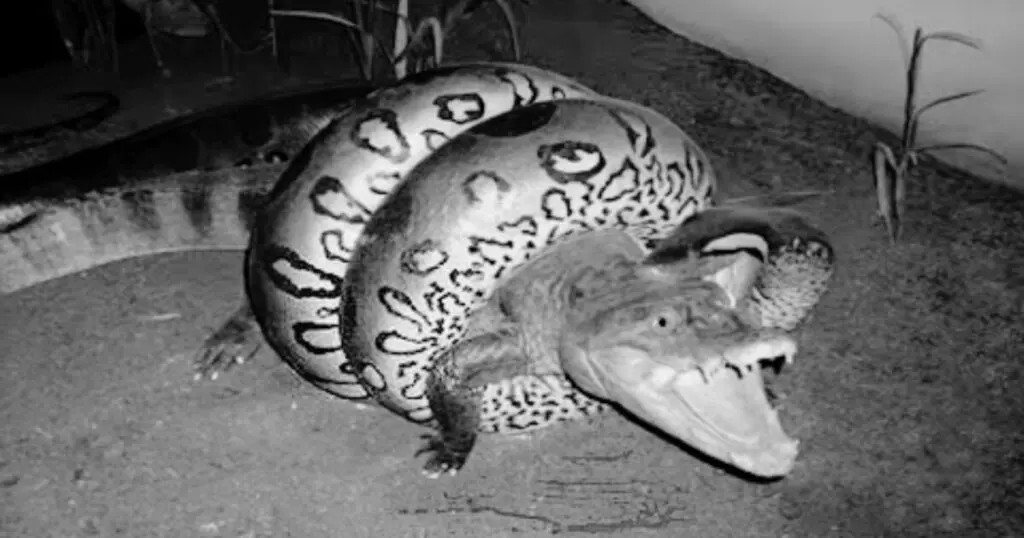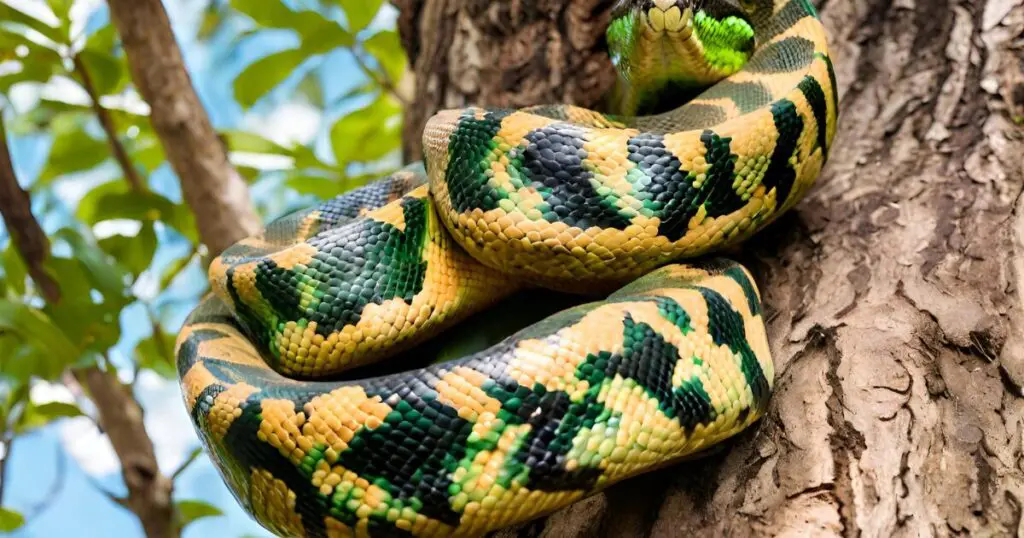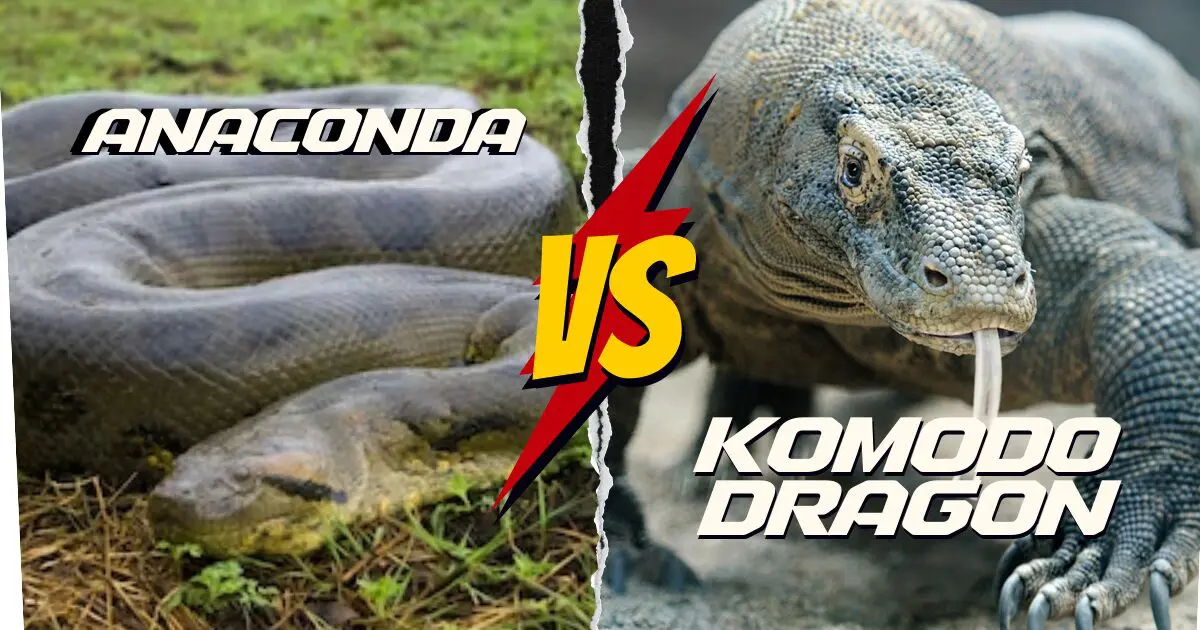Anaconda and Komodo dragons are the two most feared reptiles. You must have seen them being portrayed as hungry monsters in Hollywood movies! Therefore, Komodo dragon vs Anaconda is a common discussion when it comes to monster reptiles.
Both Komodo dragons and anacondas are apex predators. But they hold key differences. Komodo dragons dominate the terrain with sharp claws and venomous bites. Anacondas, giants of water, constrict prey with incredible muscle power. Though both are powerful, Anaconda has the advantage of size.
But wait. I am not drawing any conclusions yet. Let’s discuss or have a proper hypothetical fight using our imagination and data to see who wins the battle! This will be fun.
Key points of the article:
- Anacondas and Komodo dragons live in different part of the world, so they do not fight in real
- Anaconda is more likely to win a fight if they would break in a fight
- Komodo dragons pose a bigger threat for humans
- Anaconda is more dangerous in water, while Komodo dragons rule in land.
- Komodo dragons are venomous and have strong bite, while anaconda’s bites are weak.
Komodo Dragons vs Anaconda: Introduction
It is going to be a fight simulation. Therefore, before the fight, let us see the attributes of our contestant. Have a good look at the table below:
| Feature | Komodo Dragon | Anaconda |
| Class | Reptile (Lizard) | Reptile (Snake) |
| Scientific Name | Varanus komodoensis | Eunectes murinus (Green Anaconda) |
| Average Height | Up to 6 ft at the shoulder | Up to 2 feet |
| Average Weight | 300 lbs | 500 lbs |
| Origin | Komodo Islands, Indonesia | Tropical rainforests of South America |
| Temperament | Solitary, opportunistic predator | Solitary ambush predator |
| Appearance | Large lizard with thick legs, sharp claws, and a long tail | Massive snake with green and yellow patterned scales |
| Hunting Weapon | Sharp claws, serrated teeth, venomous bite | Constricting body |
| Speed | Faster on land | Slow and deliberate on land |
| Climbing | Can climb young trees | Poor climber |
| Swimming | Strong swimmer | Excellent swimmer |
| Social Behavior | Solitary except for mating | Solitary except during breeding season |
| Lifespan | Up to 30 years | Up to 10 years in the wild (longer in captivity) |
| Bite Power | Strong crushing force | Weak |
| Intelligence | Considered intelligent for a reptile | Not much |
Komodo Dragon vs Anaconda: The Fight Begins
Now, it is the time we begin the fight. It will be a seven-round competition. Let’s see what happens:
Round 1: Size
This is a battle of titans! But with a clear winner in terms of sheer mass. Anacondas reign supreme in size.
- Anaconda: These behemoths can reach staggering lengths of up to 30 feet (9 meters) and weigh a whopping 500 pounds (227 kg). They are the undisputed heavyweight champions of snakes.
- Komodo Dragon: They can be big as well. However, in comparison to Anaconda, they are actually dwarfs! Komodos can be 3 feet at max and usually weigh less than 300 pounds!
So, the winner of the first round is obviously Anacondas! We are 1-0 now.
Round 2: Temperament

Both Komodo dragons and anacondas are solitary ambush predators. Yet, their approaches differ.
- Komodo Dragon: These are opportunistic feeders. They can be aggressive if hungry. Also, they scavenge and may even attack weakened prey. They can be unpredictable and fiercely territorial during mating season.
- Anaconda: Anacondas are more patient ambush hunters. They lie in wait for prey to come close before striking. Generally less aggressive than komodo dragons. They focus on conserving energy and striking decisively.
The actual aggression depends on the situation. But usually, Komodo dragons are more aggressive. However, anacondas’ focus and ambush tactics could give them the upper hand in a surprise encounter. Let’s call this round a draw! We are still at Komodo dragon 0:1 Anaconda.
Also read: Komodo dragon vs Honey badger
Round 3: Hunting Weapon
This round highlights the distinct predatory styles of these giants. Both these reptiles are equipped with specific weapons to hunt their prey.
- Komodo Dragon: They are armed with an arsenal for a brutal takedown. Razor-sharp claws can rip flesh, while serrated teeth inflict savage wounds. Their surprising venom weakens prey. It allows the dragon to follow and exploit the victim’s weakened state. Unlike Anacondas, they won’t even wait for the death of their prey.
- Anaconda: Their weapon is pure power in construction. Anacondas lack limbs and rely on their muscular bodies to coil around prey. They squeeze with incredible force. This cuts off breathing and blood flow and leads to suffocation and death.
Who wins? This is a close call. Komodo dragons have a more versatile attack, but anacondas excel at pure constriction. In a direct flight, the Anaconda’s crushing ability could overpower the Komodo dragon’s defenses. Therefore, Anaconda wins again. It is the Anaconda 2:0 Komodo dragon.
Round 4: Speed
This is where the table is about to turn. Komodo dragons, despite their size, can burst at a speed of 13 mph on land. This agility allows them to chase down prey or escape threats.
Anaconda, in contrast, is much slower on land. They typically move at a sluggish pace of around 3 miles per hour. In water, though, they are agile swimmers. Still, it’s a win for the Komodo dragons. Now we are at 2:1.
Round 5: Intelligence

Intelligence might tip the scales. A Komodo dragon’s cunning could help overcome the Anaconda’s size advantage. But are they intelligent enough?
- Komodo Dragon: Considered intelligent for a reptile. They exhibit problem-solving skills. They’ve been observed working together to take down prey, using tools to reach out-of-reach food, and even remembering successful hunting locations.
- Anaconda: Anacondas are not as intelligent as Komodos. Yet, they are not mindless either. They exhibit basic learning as well. These snakes can remember good hunting smells and smells of food, too.
Winner of this round? Komodo Dragon. Their documented problem-solving abilities and capacity for strategizing give them a slight edge.
Komodo dragons 2:2 Anaconda.
Also read: Komodo dragons vs Monitor lizard
Round 6: Special Abilities
Physical strength is not the only x-factor in a fight. These titans have unique abilities that can influence the fight.
The fight can shift depending on the terrain. Komodo dragons have an advantage on land with their decent climbing and surprising jumping ability. It allows them to ambush from above or escape a tight squeeze. Their keen sense of smell helps locate prey, especially carrion.
Anacondas, however, dominate in water with their powerful swimming. Additionally, their heat-sensing pits detect warm bodies in low light. Their constriction efficiency is unmatched. These reptiles adjust pressure based on the prey’s struggle.
Who is winning this round? It depends on the battleground. If it is on land, then Komodo dragons will have an advantage. In water? It is an anaconda, for sure. Therefore, this round is a tie, too.
Komodo dragons 2:2 Anacondas.
Round 7: Strength
This is our final round. We are at a tie, and whoever wins this round takes the “W.” Besides, strength is obviously the most important aspect in animal combats.
- Komodo Dragon: They pack a punch with their powerful legs and sharp claws. Think of a wrecking ball with a bad case of halitosis. While not the strongest constrictors, they can deliver a nasty bite that can weaken prey.
- Anaconda: Their secret weapon? It’s not exactly high-tech. Pure, unadulterated squeeze power. They can coil around prey with enough force to crush watermelons (or a Komodo dragon’s fragile ego).
This is a close call. Anacondas have the upper hand in constriction, but Komodo dragons shouldn’t be underestimated. It might come down to who gets the first good grip. It is kind of like a hilarious reptilian tug-of-war gone wrong.
The Winner
So, we have to announce a winner, don’t we? Actually, both can win in their best times. You cannot say for sure who would win in a real fight. On land, it is a Komodo dragons game, and in water, it will be the anacondas who win.
Komodo Dragon vs Anaconda: Who Is Good as Pets?
Absolutely not! These giant reptiles are only good for forests and the wild. Having them as pets? It’s a big no-no!
- Both these animals are large in size and not suitable for petting.
- They pose a danger to humans and are illegal for humans.
- Their diet consists of different kinds of meat. You may not be able to replicate their diet in captivity. It will be very expensive, too.
- These reptiles require a special environment for survival, which is difficult to maintain in captivity.
- Recorded documents tell us that they attack and feast on humans.
Komodo Dragon vs Anaconda: Can They Be Friends?
Komodo dragons and anacondas are both scary reptiles. But being best friends? Not likely. It would have been an awkward playdate for them. Here’s why their hangout wouldn’t work:
- These reptiles consider most other animals as prey. Both would like to have each other on their diet menu; surely, it is not a good start for a friendship.
- Komodo dragons rule the hot, dry Indonesian islands. Anacondas prefer the steamy jungles of South America. A friendly tour spot would be difficult to choose.
- Anacondas can grow to 20 feet and crush a cow. Komodo dragons are the undisputed kings of lizards but at 10 feet. Most importantly, both are aggressive animals. It wouldn’t take much time to break into a death match.
Komodo Dragons vs Anacondas: Who Is A Bigger Danger for Humans?

Anacondas are bigger, stronger, and scarier. But you know what? Between these two hungry beasts, Komodo dragons pose greater threats to humans.
Anacondas live in jungles, so human encounters with them are limited. On the other hand, Komodo dragons inhabit popular tourist destinations in Indonesia. You have a higher chance of encountering a dragon than an anaconda.
Anacondas are ambush predators, just like Komodo dragons. However, their targets are usually smaller prey. On the other hand, Komodo dragons have been known to attack weakened humans. Check this article, where I have mentioned a few real-life incidents of Komodo dragons attacking humans.
Moreover, the attack of Komodo dragons is more severe and fatal for humans. Nonetheless, you should be aware enough not to be in front of any of the two in real-life close range.
Conclusion
I hope you enjoyed this Komodo dragon vs anaconda death battle. Thankfully, these animals do not fight in real life because of geographical differences. Otherwise, it would have been a clash of titans. As a human being, you need to maintain a safe distance from both for safety.
